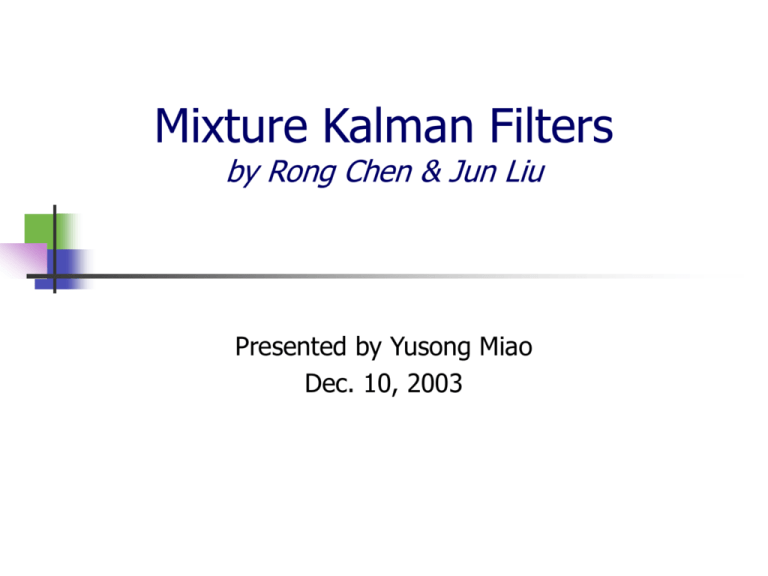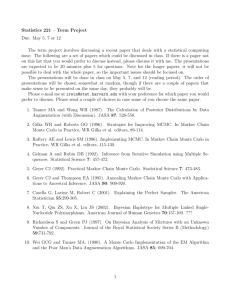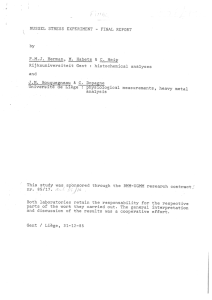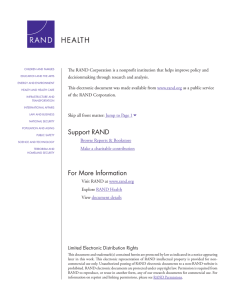Mixture Kalman Filters by Rong Chen & Jun Liu
advertisement

Mixture Kalman Filters
by Rong Chen & Jun Liu
Presented by Yusong Miao
Dec. 10, 2003
Structure
Introduce the originals of the problem
Mixture Kalman Filters (MKF) model setup
and method
Two related extended models w/ examples
Applications to show the advantages of MKF
Conclusions
Original of the problem
Interest in on-line estimation and prediction of the dynamic
changing system. (Hidden pattern along observations)
Kalman filter (1960) technique can OK Gaussian linear system.
How about non-linear & non-Gaussian system?
------Sequential Monte Carlo approach including:
Bootstrip filter / practical filter;
Sequential imputation;
From on now, call it as “Monte Carlo filters”
------Mixed kalman filter, the role of this paper.
Will see the comparisons.
Original of the problem
Before we start MKF, recall the task:
MKF model setup
Conditional dynamic linear model (CDLM):
Given trajectory of an indicator variable, the system is Gaussian &
linear-- can derive a MC filter focusing on attention on the space
of indicator variables, named Mixed Kalman Filter.
MKF model setup
Example 1: A special CDLM (Linear system with non-Gaussian
errors) as the follow:
In the CDLM system MKF is more sophisticated, outperform
other methods (i.e.. bootstrap filter).
Use a mixture of Gaussian distribution to estimate the target
posterior distribution.
MKF model setup
The method of MKF
Use a weighted sample of the indicators:
To represent the distribution p(Λt|yt) a random mixture of
Gaussian distribution:
Can approximate the target distribution p(xt|yt).
MKF model setup
Algorithm (updating weights)---If you are interested in:
Extended MKF with examples
Beside the situation of CDLM, there is a extended one called
partial conditional dynamic linear models (PCDLM).
PCDLM are interested in non-linear component of state variables.
No absolute distinction between CDLM and PCDLM.
Extended MKF with examples
Example: Fading channel modeling system
(mobile communication channel can be modeled as Rayleigh flat fading channels)
Extended MKF with examples
Example: Blind deconvolution digital communication system
Where St is a discrete process taking vales on a known set S. It is
to be estimated from the observed signals {y1,…,yt}, without
knowing the channel coefficients θi.
There two examples can be solved by extended MKF called EMKF.
Extended MKF with examples
Why EMKF? It can deal with as many linear and Gaussian
components from systems as possible.
P(xt1,xt2|yt)=P(xt1|xt2,y)*P(xt2|yt), Monte Carlo
approximation of P(xt2|yt) and an Gaussian conditional
distribution p(xt1|xt2,y).
Need to generate discrete samples in the joint space of the
indicators and the non-linear state components.
Extended MKF with examples
Algorithm (updating weights)
Application of MKF-Target tracking
Situation setup:
The tracking errors (differences between the estimated and
true target location) are generated and compared with other
methods.
Application of MKF-Target tracking
The result proves the advantage of MKF:
Application of MKF-2 D target’s position
A 2-D target’s position is sampled every T=10s. We know the
movement and velocities on both x and y directions. Use MKF to
simulate the results and compare them with the actual data.
Model setup:
1
0
H
0
0
0 10 0
1 0 10
1 0 0 0
, F
,
G
0 1 0
0
1
0
0
0 0 1
5
0
1
0
0
5
5
2 0
,
W
w
1
0
0
1
0
5
2 1 0
,
V
v
0 1
0
1
Application of MKF-2 D target’s position
The result proves the advantage of MKF:
Better than the tradition way done by Bar-Shalom & Fortmann
Other applications of MKF
There are still several other applications with brief
introduction can be found on the paper.
Random (non-Gaussian) accelerated target (no clutter).
Digital signal extraction in fading channels.
They are both improved under MKF approach comparing
with traditional Monte Carlo approach.
Conclusions
MKF can perform real time estimation and prediction in
CDLM situation, which outperform Sequential Monte Carlo
approaches.
Similar to EMKF in PCDLM situation.
MKF can combine with other Monte Carlo techniques
(Markov chain Monte Carlo updates, delayed estimation,
fixed lag filter, etc.) to improve effectiveness.
Sequential Monte Carlo method can be a platform for
designing efficient non-linear filtering algorithms.
Questions & Answers









